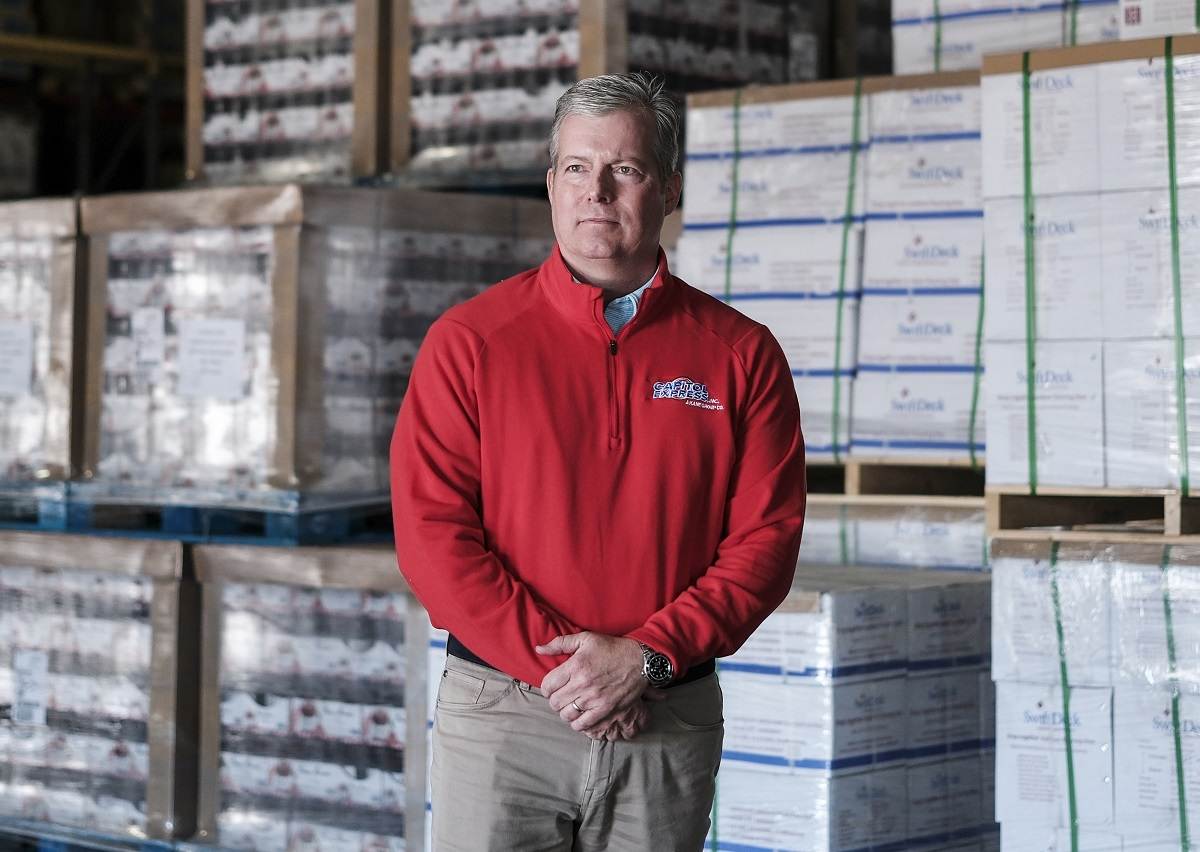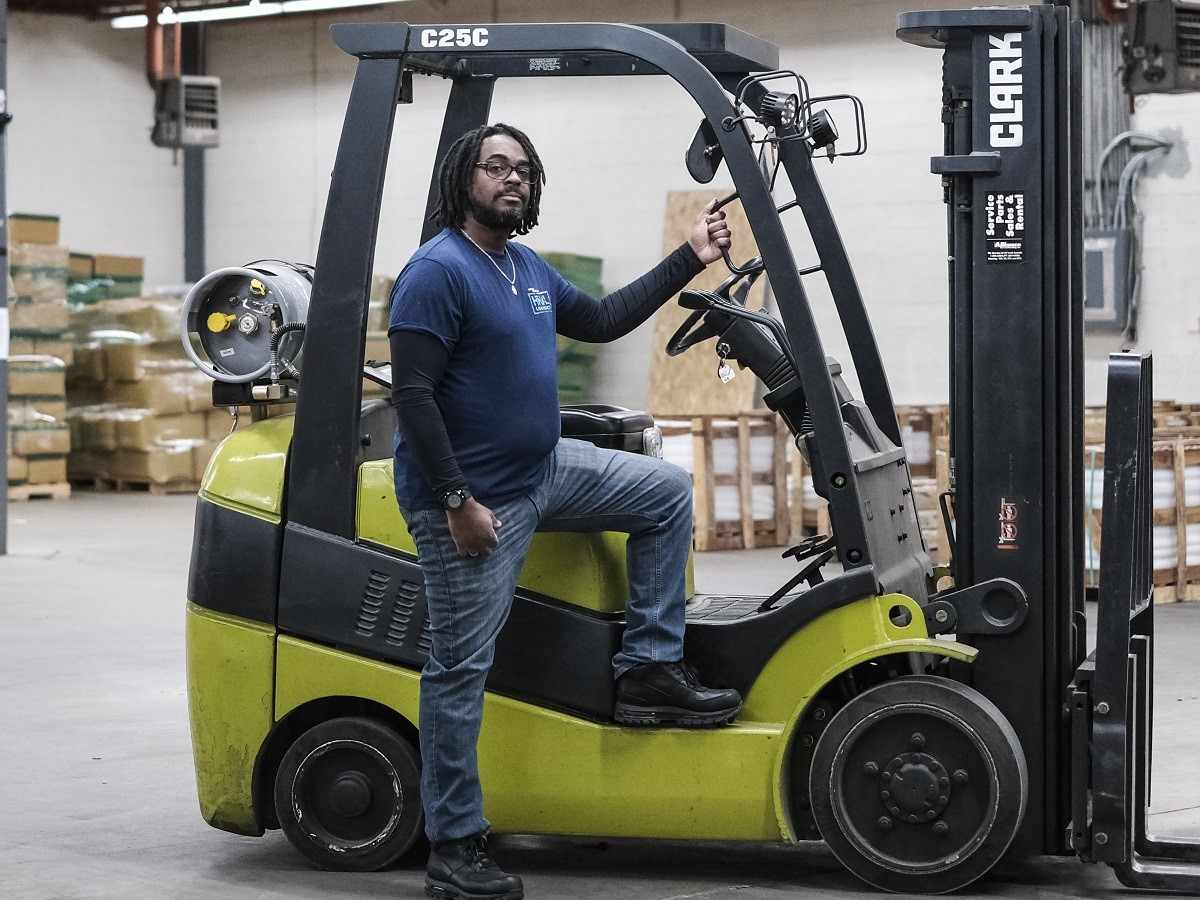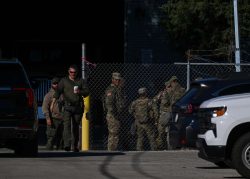
Downtown Baltimore.
15:32 JST, April 1, 2024
BALTIMORE – Trucks still rumble down Holabird Avenue while freight trains sound their horns. But the lunchtime crowd at Vinny’s Cafe, a popular Italian joint favored by dockworkers, is lighter than usual. And people here confess to an uneasy feeling they liken to the first days of the coronavirus pandemic.
Less than a week has elapsed since a mammoth ocean freighter struck the Francis Scott Key Bridge, marooning the Port of Baltimore behind a barricade of crooked steel and shattered concrete.
With the shipping channel clogged with debris, the people and businesses who depend on the port for their living are in limbo. The docks will soon be clear of cargo, and no more will be arriving anytime soon. Logistics and freight companies as well as retail businesses are bracing for a lengthy interruption in port operations that could exact a steep financial toll.
“We believe it’s going to be six months. That’s what we’re telling our shippers,” said Rich Kane, 54, who owns trucking, warehousing and freight brokerage businesses that serve the port under the Kane Group.

Rich Kane is president and CEO of Kane Group’s Capitol Express.
Even if it does not take that long, clearing the stricken vessel and ruined bridge will not be quick or easy. This temporary cargo halt could become one of the greatest blows to Baltimore’s maritime prosperity since the city emerged as a commercial gateway with the tobacco trade in the 1600s.
For the United States as a whole, the port closure will have “no significant effects” on economic growth or inflation, according to Capital Economics. But it is a cataclysm for the regional economy and for hopes of adding blue-collar jobs. Some freight and transport executives compared the situation to other epic disasters.
“For me, it’s like covid or 9/11, the two things that basically stopped us in our tracks,” said John Schmidt, chief operating officer of Kane’s Capitol Express unit. “The longer this goes on, the worse it’s going to get.”
On Friday, a maritime crane capable of hefting 1,000 tons arrived in Baltimore, the first step toward removing the tangle of ship and bridge that blocks the Patapsco River and access to the ocean.
The work above and below the water is expected to be dangerous and time-consuming. After the debris is removed, a years-long project to erect a new bridge will begin. Cargo ships will be able to call at the port while that rebuilding proceeds, transportation experts said.
“I’m pretty sure once that channel is opened, the port will be able to handle all of the business they’ve handled in the past,” said Jim White, who retired in 2019 after 18 years as the port’s executive director. “The problem right now is nobody can get a handle on how long the channel will be closed.”
The reopening cannot come too soon. With no cargo ships arriving for the foreseeable future, port activity is beginning to ebb.
The number of trucks calling at Seagirt Marine Terminal, one of the port’s five cargo-handling centers, fell every workday last week. By Thursday, the 2,889 truck transactions recorded were almost 20 percent lower than on Monday, according to the facility’s website.
Diversified operations like the Kane Group, with multiple revenue streams, are positioned to weather what’s coming. Small trucking companies that exclusively haul cargo short distances to and from the port, known as “drayage,” will suffer as will start-up businesses.
Arnez Harrison, 41, and three partners spent 18 months studying the market and raising $300,000 before launching HHAL Logistics last summer. One of the rare minority-owned companies in the trucking industry, it was struggling to become profitable before the bridge collapsed.
“This could potentially be devastating for us. I’m very worried, very worried,” he said.
Harrison was raised in a blue-collar Baltimore family. He spent a few years bouncing between prelaw and pre-med studies before teaching in Anne Arundel County. Later, he took a job with a mail consolidator, where he still moonlights while building the new business.

Arnez Harrison, co-founder of HHAL Logistics, is worried about how the bridge collapse will affect his business.
HHAL Logistics is his chance to be his own boss and maybe make some money. He’s in no mood to quit.
“Before this, we knew we needed to diversify in order to survive,” he said, leaning against a lime-green forklift. “Now we’ve got to move a little faster so we can stay afloat.”
Reminders of Baltimore’s faded industrial prowess dot the port environs. A General Motors plant that employed several thousand workers within sight of the water closed in 2005. Less than 10 miles away sits a former Bethlehem Steel facility on Sparrows Point.
Baltimore’s logistics cluster has been under pressure in recent years. Maryland lost about 3,100 trade and transportation jobs since 2019, even as nationwide employment in the sector grew by nearly 5 percent.
The bridge collapse came as the port was coming off a record year in cargo handling while awaiting infrastructure improvements that were expected to make it more competitive.
Instead of building on that success, the port now is all but frozen. Cargo carriers such as Maersk and Evergreen have begun diverting container ships to ports in New York, New Jersey and Norfolk. In most cases, the companies that own the goods will be responsible for the cost of bringing them to Baltimore by truck or rail from the new destination port.
On Wednesday, Kane held a Zoom call with 10 of his largest shippers and secured their agreement to pay a temporary fee to cover the added cost of any new routes for their goods. Given all the uncertainty, it will be a few weeks before he knows how much to charge.
Kane, whose family has been in the transport business since 1918, said one client ordered five times their normal amount of goods, fearing that congestion at other ports could leave them short of what they need.
“They’re loading up on inventory. Right now, shippers don’t know what’s going to happen,” he said.
Ocean carriers, like airlines, provide scheduled service to specific destinations. Once they change those schedules – and shippers grow accustomed to moving their goods through a different port – Baltimore may struggle to regain business it has lost.
Contracts to handle cargo that come from, or is bound for, customers in the Baltimore region would quickly return once the port resumes operations.
But more than half of the goods that arrive in Baltimore in a typical year are headed to more distant spots like Chicago, according to John D. Porcari, former Maryland transportation secretary. That “discretionary” cargo could easily flow into another East Coast gateway, especially if the price is right.
“What ports do best is steal discretionary cargo,” said Porcari, who was President Biden’s port envoy during the pandemic supply chain crisis. “Long term, Baltimore may lose some discretionary cargo – and that hurts.”
Craig McGraw worries that a contract he was hoping to receive from a Houston power company may be among the work that heads elsewhere.
McGraw, 42, the vice president of sales and marketing for Trans American Trucking Service, which specializes in handling industrial components, recently bid on a job to truck the Houston company’s equipment from Baltimore to Ohio. The components will be used in Intel’s $20 billion semiconductor plant, which is being constructed northeast of Columbus. That work was scheduled to start in August. Now the contract’s fate is unclear.
McGraw’s father Ron, now 83, started the business in 1976 with a single flatbed trailer. Trans American, headquartered in South Plainfield, N.J., now has about 50 drivers, evenly split between staff and owner-operators, handling loads from the port of Baltimore.
Though McGraw expects revenue to slide starting next month, McGraw has no plans to cut his workforce. During the 2008 financial crisis, everyone – including top executives – took a significant pay cut, he said.
“We pride ourselves that we’ve never laid anybody off,” he said.
Still, one customer has decided to ship its coiled electric cabling via the port of Newark while Baltimore is sidelined. And others are certain to follow.
“If they get comfortable, will that ever come back to Baltimore?” he said.
After more than four centuries as a trading center, Baltimore has reasons for optimism.
The port is one of only four on the East Coast with the 50-foot channel depth needed to welcome the “New Panamax” class of ships, which carry over 10,000 shipping containers.
By virtue of its location on the Patapsco River at the top of the Chesapeake Bay, Baltimore is farther inland than any other rival port and thus closer to key Midwestern transport hubs like Chicago. Baltimore is also less congested than alternatives such as New York-New Jersey.
A major expansion of the city’s Howard Street tunnel to accommodate freight trains carrying double-stacked shipping containers, scheduled to open in 2027, also will make Baltimore a more attractive freight channel. State officials expect the project to create 7,300 permanent jobs.
Many may become patrons of Vinny’s Cafe, about a mile from the port. For 25 years, the family-owned restaurant has done a thriving business with the port, including catering for events. Last week, the impact of the bridge mishap could be seen in the thin walk-in lunch crowds.
Asked about the impact of a long closure, owner Vinny Scotto, 65, grimaced. “It won’t be pretty, like having an artery to the heart clogged up,” he said. “It won’t be good for this side of town.”
His son, Fabrizio, who manages the cafe, says he feels for the port workers but is confident the restaurant will navigate any tough times. The Scottos recently opened a renovated dining room, complete with a gleaming horseshoe-shaped bar, which is drawing good evening business.
“This is heartbreaking,” Vinny said. “I used to live across the street. I see the bridge every day.”
"News Services" POPULAR ARTICLE
-

American Playwright Jeremy O. Harris Arrested in Japan on Alleged Drug Smuggling
-

Japan’s Nikkei Stock Average as JGB Yields, Yen Rise on Rate-Hike Bets
-

Japan’s Nikkei Stock Average Licks Wounds after Selloff Sparked by BOJ Hike Bets (UPDATE 1)
-

Japan’s Nikkei Stock Average Buoyed by Stable Yen; SoftBank’s Slide Caps Gains (UPDATE 1)
-

Japanese Bond Yields Zoom, Stocks Slide as Rate Hike Looms
JN ACCESS RANKING
-

Tokyo Economic Security Forum to Hold Inaugural Meeting Amid Tense Global Environment
-

Keidanren Chairman Yoshinobu Tsutsui Visits Kashiwazaki-Kariwa Nuclear Power Plant; Inspects New Emergency Safety System
-

Imports of Rare Earths from China Facing Delays, May Be Caused by Deterioration of Japan-China Relations
-

University of Tokyo Professor Discusses Japanese Economic Security in Interview Ahead of Forum
-

Japan Pulls out of Vietnam Nuclear Project, Complicating Hanoi’s Power Plans
























